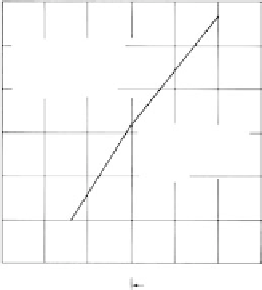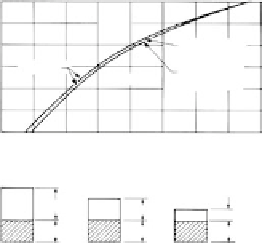Environmental Engineering Reference
In-Depth Information
100
Case I
95
Little or no additional
volume change on saturation.
No foundation treatment
required for small dams and
canal embankments.
60
2.60 Specific
gravity
2.70 Specific
gravity
90
80
Case II
Case III
85
Significant amount of
volume change on
saturation.
Foundation treatment
required.
100
10
20
30
40
50
60
70
80
90
80
Liquid limit (%)
Case I
Case II
75
Case III
Voids
Solids
Voids
Solids
Voids
Solids
70
−
15
−
10
−
5
0
5
10
15
Loose
Voids equal to the
water volume at the
liquid limit
Dense
% wet
Optimum
% dry
0
−
=
optimum water content (% by dry weight)
−
natural water
content (% by dry weight)
(a)
(b)
FIGURE 7.72
Criteria for treatment of relatively dry fine-grained foundations: (a) “
D
ratio,” the ratio of natural (in place) dry
density to Proctor maximum dry density, and
, optimum water content minus natural water content and
(b) natural dry density and liquid limit. (From USBR,
Earth Manual
, 2nd ed., U. S. Bureau of Reclamation,
Denver, Colorado, 1974. With permission.)
ω
o
−ω
TABLE 7.11
Settlement upon Saturation vs. Natural Density: Loessial Soils from Kansas and Nebraska
a
Density
g/cm
3
D
R
pcf
Settlement Potential
Surface Loading
Loose
80
1.28
Highly susceptible
Little or none
Medium dense
80-90
1.28-1.44
Moderately susceptible
Loaded
Dense
90
1.44
Slight, provides capable support
Ordinary structures
a
From USBR,
Earth Manual
, 2nd ed., U.S. Bureau of Reclamation, Denver, Co, 1974. With permission.
Note
:
85 pcf (1.36 g/cm
3
) has been used as the division
between high-density loess requiring no foundation treatment, and low-density loess requiring treat-
ment.
(2) Moisture contents above 20% will generally result in full settlement under load.
γ
(1) For earth dams and high canal embankments,
dense loess becomes less than 4 psi (0.28 tsf). The breakdown can occur at 20 to 25% mois-
ture content, which is of the order of 50 to 60% saturation.
Compacted Fills
When loess is dry (typical natural conditions) compacting is virtually impossible. If placed
in an embankment in an excessively wet condition, it can become “quick,” suddenly losing
strength and flowing. At proper moisture content loess makes suitable compacted embank-
ment fill, but it must be protected against piping erosion, considered to be one of the causes
of the Teton Dam failure (see
Section 8.3.4).
A large shrinkage factor must be used in esti-
mating earthwork and a thick vegetative cover must be provided for erosion protection.
Site Preparation
Stripping the natural vegetation leaves loess vulnerable to rainfall saturation and possible
ground collapse. Site grading and drainage require careful planning to avoid the ponding
of water, and utilities must be constructed so as to prevent leaks.








